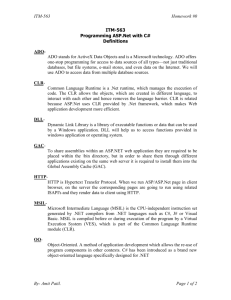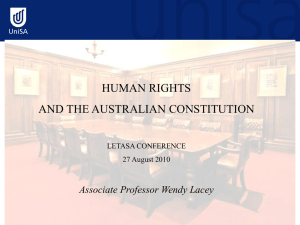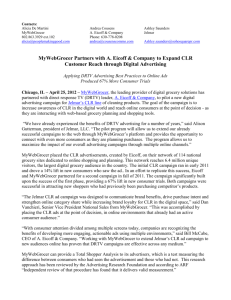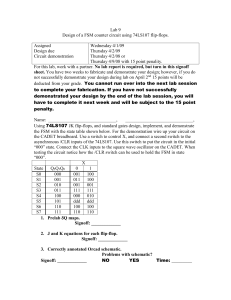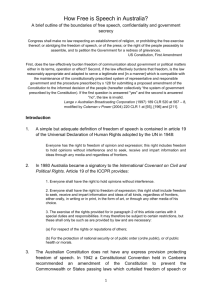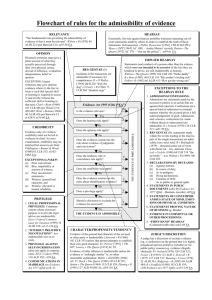constitutional law summary
advertisement
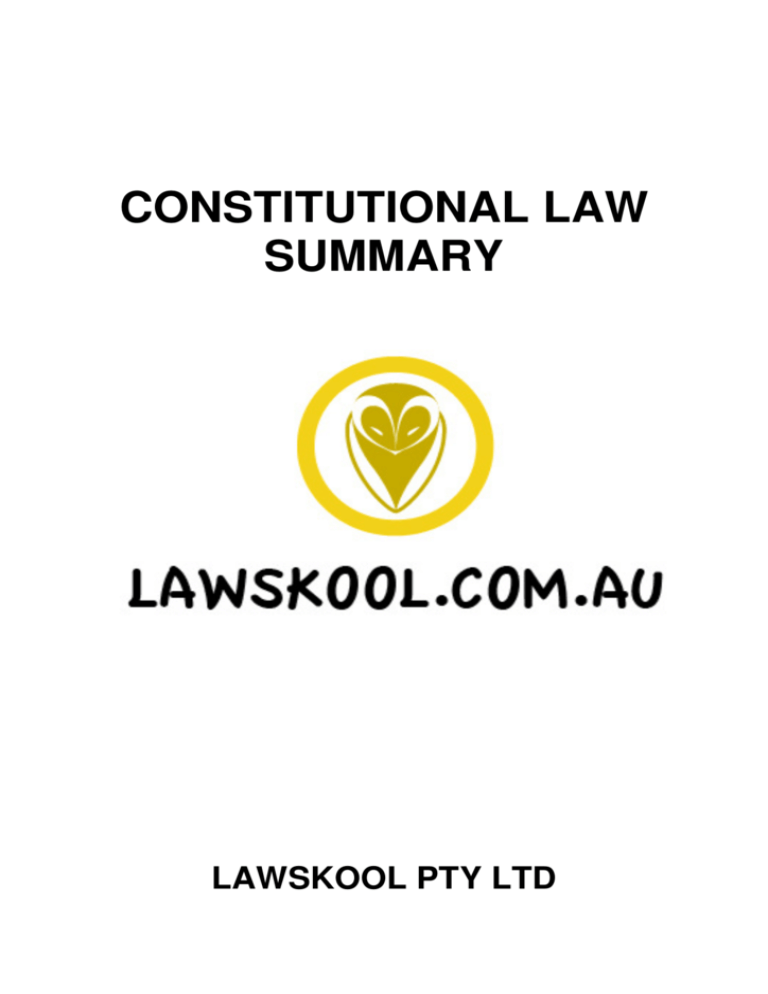
CONSTITUTIONAL LAW SUMMARY LAWSKOOL PTY LTD CONSTITUTIONAL LAW TABLE OF CONTENTS CASE INDEX ______________________________________________________________ 5 INTRODUCTION ___________________________________________________________ 7 PRINCIPLES OF CHARACTERISATION...............................................................8 The Central Question ................................................................................... 8 Considerations: ............................................................................................ 8 The Test ....................................................................................................... 9 Tools of Interpretation................................................................................. 10 Characterisation...................................................................................................10 The Definition.......................................................................................................12 Sources of Incidental Power ................................................................................12 Sufficient Connection Test ...................................................................................12 1. The Test for a Sufficient Connection: ................................................. 13 Reasonable Proportionality ..................................................................................13 TRADE AND COMMERCE POWER ___________________________________________ 15 The meaning of ‘trade’ and ‘commerce’ ...............................................................15 1. Trade and commerce have the same meaning throughout The Constitution ...................................................................................................... 15 2. Give ‘trade’ and ‘commerce’ their popular meaning............................ 15 What does ‘trade’ include?...................................................................................15 What can the Commonwealth regulate? ..............................................................16 1. Trade and Commerce with other countries and between States......... 16 2. Not Intrastate trade and commerce .................................................... 16 CHARACTERISATION OF SECTION 51(i) ______________________________________ 16 Core Area of the Trade and Commerce Power ....................................................16 Regulation of Core Area.......................................................................................17 CORPORATIONS POWER __________________________________________________ 23 Scope of the Power..............................................................................................23 The meaning of Corporation.................................................................................24 1. Foreign Corporations ......................................................................... 24 2. Trading Corporations ......................................................................... 24 Purpose of trading activities:....................................................................... 24 3. Financial Corporations ....................................................................... 25 Regulating Activities of Corporations....................................................................26 Trading Activities ........................................................................................ 26 Third Parties ............................................................................................... 27 Non-trading Activities.................................................................................. 28 Current law following WorkChoices Case ................................................... 29 Formation/incorporation of corporations outside of s51(xx) ..................................30 THE EXTERNAL AFFAIRS POWER ___________________________________________ 31 Scope of the External Affairs Power.....................................................................31 The Treaty Implementation Power.............................................................. 31 The Extraterritorial Power ........................................................................... 36 THE RACES POWER ______________________________________________________ 38 Interpreting the Races Power...............................................................................38 Original Intent ............................................................................................. 38 Textual Approach ....................................................................................... 38 Contemporary Values Approach................................................................. 38 What is covered by the Races Power?.................................................................39 lawskool.com.au © Page 2 CONSTITUTIONAL LAW Differential Operation.................................................................................. 39 Matters of Special Significance................................................................... 40 Race........................................................................................................... 40 Subgroups of Race..................................................................................... 40 Regulation of the Power.......................................................................................40 The General Proposition............................................................................. 40 Limitations: where the Courts will intervene ................................................ 41 Does the Commonwealth have the power to make detrimental laws? ........ 41 THE DEFENCE POWER ____________________________________________________ 43 Principles of the Defence Power ..........................................................................43 The Test ..................................................................................................... 43 Examples of the Defence Power Invoked.............................................................43 Characterisation...................................................................................................44 Application – Terrorism & National Security .........................................................45 THE TAXATION POWER____________________________________________________ 46 Characterisation...................................................................................................46 Test for Characterising a law under the Taxation Power............................. 46 Definition..............................................................................................................46 The Elements of a Tax .........................................................................................46 1. Compulsory exaction enforceable by law ........................................... 47 2. Exaction is for public purposes........................................................... 47 3. Not Arbitrary or Incontestable............................................................. 47 4. Not a Payment for Service ................................................................. 48 5. Not a Penalty ..................................................................................... 49 6. Not another non-tax exaction ............................................................. 49 Summary .............................................................................................................50 THE GRANTS POWER _____________________________________________________ 51 What is covered? .................................................................................................51 What is not covered? ...........................................................................................52 Can s. 96 be used to discriminate between States?.............................................52 The Broad Approach .................................................................................. 52 Limitations .................................................................................................. 53 EXCISE DUTIES __________________________________________________________ 54 What is an Excise? ..............................................................................................54 The Tests.............................................................................................................55 A Tax Relating to Goods ............................................................................ 55 Licensing Fee Exemption ........................................................................... 56 Excise Today .......................................................................................................57 THE EXECUTIVE POWER __________________________________________________ 58 What is the Scope of the Power? .........................................................................58 The Narrow View........................................................................................ 58 The Middle View......................................................................................... 58 The Broad View.......................................................................................... 59 THE APPROPRIATION POWER ______________________________________________ 61 What does ‘for the purposes of the Commonwealth’ mean? ................................61 The Narrow View........................................................................................ 61 The Broad View.......................................................................................... 62 THE NATIONHOOD POWER ________________________________________________ 64 Sources of the Nationhood Power........................................................................64 Where is the Nationhood Power Invoked? ...........................................................64 The Test ..............................................................................................................65 lawskool.com.au © Page 3 CONSTITUTIONAL LAW 1. 2. Source of Power ................................................................................ 65 The Test; Davis v Commonwealth: .................................................... 65 FREEDOM OF INTERSTATE TRADE__________________________________________ 66 1. Burden on Interstate Trade...................................................................66 2. Discriminatory Burden ..........................................................................66 What is Discrimination? .............................................................................. 67 There are Four Types of Discrimination...................................................... 67 3. Discrimination is of a Protectionist Kind ................................................68 4. Discrimination is not Justified................................................................68 The Qualification ........................................................................................ 68 The Tests ................................................................................................... 68 FREEDOMS IMPLIED FROM REPRESENTATIVE GOVERNMENT __________________ 70 The Freedom of Political Communication.............................................................70 The Test of Freedom of Political Communication .................................................70 Does the Law burden political communication? .......................................... 71 Is the burden permissible?.......................................................................... 71 Freedom of Political Communication and Defamation..........................................73 1. Communication Must Be Political ....................................................... 73 2. What is the Protection? ...................................................................... 73 Freedom of Political Communication and Territories ............................................73 Freedom of Political Communication and the States ............................................74 Freedom of Association and Movement ...............................................................74 Express rights and freedoms _________________________________________________ 75 ‘Just terms’ for acquisition of property ..................................................................75 States’ right to use waters....................................................................................75 IMMUNITIES _____________________________________________________________ 77 State Immunities ..................................................................................................77 1. Does the Act purport to apply to a State?........................................... 78 2. Does the Act discriminate against the State? ..................................... 79 3. Does the Act impair the State’s capacity to function (The Destruction Principle)? ........................................................................................................ 80 Commonwealth Immunities..................................................................................81 Cooperative Federalism .......................................................................................83 The Scope of Cooperative Federalism........................................................ 83 Limitations .................................................................................................. 83 Contentious Issues..................................................................................... 84 INCONSISTENCY _________________________________________________________ 88 The Test ..................................................................................................... 89 Manufactured Inconsistency ....................................................................... 91 Preventing Inconsistency............................................................................ 91 SOURCES CONSULTED ___________________________________________________ 93 lawskool.com.au © Page 4 CONSTITUTIONAL LAW CASE INDEX Actors & Announcers Equity Association v Fontana Films Pty Ltd (1982) 150 CLR 169 Australian Capital Television Pty Ltd v Commonwealth (ACTV Case) (1992) 177 CLR 106 Australian Education Union; Ex parte Victoria (1995) 184 CLR 188 Adelaide Company of Jehovah’s Witnesses v Commonwealth (1943) 67 CLR 116 Airlines of New South Wales Pty Ltd v New South Wales (No.2) (1965) 113 CLR 54 Air Services Australia v Canadian Airlines International (1999) 202 CLR 13 Amalgamated Society of Engineers v Adelaide Steamship Co (Engineers’ Case) (1920) 28 CLR 129 Ansett Transport Industries v Wardley (1980) 142 CLR 237 Austin v Commonwealth (2003) 215 CLR 185 Australian Communist Party v Commonwealth (1951) 83 CLR 1 Australian National Airways Pty Ltd v Commonwealth (No 1) (1945) 71 CLR 29 Australian Tape Manufacturers Association v Commonwealth (1993) 176 CLR 480 Bath v Alston Holdings (1988) 165 CLR 411 Bank of NSW v Commonwealth (1948) 76 CLR 1 Baxter v Commissioners of Taxation (NSW) (1907) 4 CLR 1087 Betfair Pty Ltd v Western Australia (2008) 234 CLR 418 Bropho v Western Australia (1990) 171 CLR 1 Brown v West (1990) 169 CLR 195 Capital Duplicators Pty Ltd v Australian Capital Territory (No 1) (1992) 177 CLR 248 Castlemaine Tooheys Ltd v South Australia (1990) 169 CLR 436 Clyde Engineering v Cowburn (1926) 37 CLR 466 Cole v Whitfield (1988) 165 CLR 360 Commonwealth v Bank of NSW (Bank Nationalisation Case) (1948) 76 CLR 1 Commonwealth v Cigamatic Pty Ltd (1962) 108 CLR 372 Commonwealth v Evans Deakin Industries (1986) 161 CLR 254 Commonwealth v Tasmania (Tasmania Dam Case) (1983) 153 CLR 1 Davis v Commonwealth (1988) 166 CLR 79 D’Emden v Pedder (1904) 1 CLR 91 Ex Parte McLean (1930) 43 CLR 472 Fairfax v Federal Commissioner of Taxation (FCT) (1965) 114 CLR 1 Fencott v Muller (1983) 152 CLR 570 Grannall v Marrickville Margarine Pty Ltd (1955) 93 CLR 55 Huddart, Parker & Co v Moorehead (1909) 8 CLR 330 ICM Agriculture Pty Ltd v The Commonwealth [2009] HCA 51 James v Commonwealth (1936) 55 CLR 1 Jumbunna Coal Mine NL v. Victorian Coal Miners’ Assoc. (1908) 6 CLR 309 Kartinyeri v Commonwealth (1998) 195 CLR 337 Koowarta v Bjelke-Patersen (1983) 153 CLR 168 Kruger v Commonwealth (1997) 190 CLR 1 Lange v Australian Broadcasting Corporation (1997) 189 CLR 520 Leask v Commonwealth (1996) 187 CLR 579 Levy v Victoria (1997) 189 CLR 579 Luton v Lessels (2002) 210 CLR 333 Mabo v Queensland (No 2) (1992) 175 CLR 1 Maguire v Simpson (1977) 139 CLR 362 Matthews v Chicory Marketing Board (Vic) (1938) 60 CLR 263 McGinty v Western Australia (1996) 186 CLR 140 Melbourne Corporation v Commonwealth (1947) 74 CLR 31 lawskool.com.au © Page 5 CONSTITUTIONAL LAW Murpheyores Pty Ltd v Commonwealth (1976) 136 CLR 1 Nationwide News v Wills (1992) 177 CLR 1 New South Wales v Commonwealth (Seas and Submerged Lands Case) (1975) 135 CLR 337 New South Wales v Commonwealth (WorkChoices Case) (2006) 229 CLR 1 Ngo Ngo Ha V New South Wales (1997) 189 CLR 465 Northern Suburbs General Cemetery Reserve Trust v Commonwealth (1993) 176 CLR 555 O’Sullivan v Noarlunga Meat Ltd (1954) 92 CLR 565 Pape v Commissioner of Taxation (2009) 238 CLR 1 Peterswald v Bartley (1904) 1 CLR 497 Pirrie v MacFarlane (1925) 36 CLR 170 Polyukhovich v Commonwealth (1991) 172 CLR 501 QLD Electricity Commission v Commonwealth (1985) 159 CLR 192 Attorney-General (Vic) v Commonwealth (Pharmaceutical Benefits Case) (1945) 71 CLR 237 R v Barger (1908) 6 CLR 41 R v Burgess; Ex Parte Henry (1936) 55 CLR 608 R v Hughes (2000) 202 CLR 535 R v Judges of Federal Court and Adamson; Ex Parte Western Australian National Football League and West Perth Football Club (Adamson’s Case) (1979) 143 CLR 190 R v Sharkey (1949) 79 CLR 121 Re Dingjan; Ex Parte Wagner (1995) 183 CLR 323 Re Australian Education Union and Australian Nursing Federation; Ex Parte Victoria (1995) 184 CLR 188 Re Ku-ring-gai Co-operative Building Society Ltd (1978) 22 ALR 621 Re Residential Tenancies Tribunal of NSW and Henderson; Ex Parte Defence Housing Authority (Henderson’s Case) (1997) 190 CLR 410 Re Wakim; Ex Parte McNally (1999) 198 CLR 511 Ruddock v Vadarlis (Tampa Case) (2001) 110 FCR 491 Smith v ANL Ltd (2000) 204 CLR 493 State Superannuation Board of Victoria v Trade Practices Commission (1982) 150 CLR 282 Stenhouse v Coleman (1944) 69 CLR 457 Strickland v Rocla Concrete Pipes Ltd (1971) 124 CLR 468 Theophanous v Commonwealth (2006) 225 CLR 101 Victoria v Commonwealth and Hayden (AAP Case) (1975) 134 CLR 338 Viskauskas v Niland (1983) 153 CLR 280 W & A McArthur Ltd v Queensland (1920) 28 CLR 530 Wainohu v New South Wales [2011] HCA 24 XYZ v Commonwealth [2006] HCA 25 lawskool.com.au © Page 6 CONSTITUTIONAL LAW INTRODUCTION It is important to understand that Australian Constitutional law is made up of a number of sources, including: • • • • • • • the Commonwealth (Commonwealth) Constitution; the Statute of Westminster; the Australia Act; The Constitution Acts of the various States; Commonwealth and State legislation which deal with constitutional matters, constitutional conventions; and the courts. However, for the purposes of this document, our focus will concern the operation of the Commonwealth Constitution, which is the primary source of Australia's Constitutional law. Constitutional Law concerns the areas with respect to which the Commonwealth and State/Territory legislatures can make laws. The Constitution 1901 (Commonwealth) 1 outlines areas of power for which the Commonwealth can legislate. These are mostly listed within Section 51 of The Constitution. In all, this section contains 39 specific heads of power for which the Federal (or Commonwealth) parliament has the power to make legislation. In addition the Commonwealth government has exclusive powers in Section 52 and implied powers that will be examined. A central concern for Constitutional lawyers is whether a piece of Commonwealth legislation is lawful in so far as the law in question can rightly be characterized as falling within a recognised head of legislative power under The Constitution. This is described as ‘characterising’ a law. If the law can be described as a law on or with respect to the subject matter of the head of power, it is within power; if it lacks that connection, it is beyond power and such a law is ‘unconstitutional’. Note that Australian High Court has maintained that the process of characterisation merely determines compliance with The Constitution; the merits or efficacy of a law are not for the courts to pass judgment on. This is consistent with the Australian version of parliamentary sovereignty – the idea that Parliament’s laws are supreme and cannot be impugned except so far as they are not in conformity with constitutional requirements. Evidence of this approach can be seen in cases following the Engineers’ Case (1920) and as recently as the WorkChoices Case (2006). 1 Here after referred to as The Constitution. lawskool.com.au © Page 7 CONSTITUTIONAL LAW PRINCIPLES OF CHARACTERISATION In characterising a law the central starting point to remember is that a Commonwealth head of power should be read broadly. This is known as the Jumbunna Principle (see Jumbunna Coal Mine NL v. Victorian Coal Miners’ Assoc.2) and forms the first stage in characterising a law. In Fairfax v Federal Commissioner of Taxation3, Kitto J described the process of characterisation4 in the following manner: 'it is a question as to the true nature and character of the legislation: is it in its real substance a law upon, "with respect to", one or more of the enumerated subjects, or is there no more in it in relation to any of those subjects than an interference so incidental as not in truth to affect its character?' Justice Kitto went on to articulate the modern test of characterisation (at 7) as follows: 'the question is always one of subject matter, to be determined by reference solely to the operation which the enactment has if it be valid, that is to say by reference to the nature of the rights, duties, powers and privileges which it changes, regulates or abolishes'. The Central Question As outlined above the central question to ask yourself is: is the law supported by a head of power or can the law be seen to fall within the subject matter of a power? Considerations: In interpreting the words used in The Constitution and the scope of those words, it is important to remember that since the Engineers’ Case5, the High Court has departed from the principled basis adopted in Barger6 after rejecting the doctrine of “reserved state powers”. The old position required that a given power be interpreted with regard to their “true nature and character” such that the Commonwealth was strictly limited to its enumerated powers under s. 51 (etc). This was done in a purported effort to protect Federalism and the “federal balance” (see Barger7). Under the modern, formalistic approach, cases such as Barger8 were based too much on principles borrowed from jurisdictions such as the US and Canada. However, fundamental differences between those jurisdictions and Aust (namely different conceptions of responsible govt and the fact that the law-making powers of both tiers of govt in Canada are enumerated) makes this inappropriate and risks inconsistent divergences in the law. Therefore, The Constitution must be interpreted according to the ordinary principles of interpretation applicable under the common law of the United Kingdom. 2 (1908) 6 CLR 309 3 (1965) 114 CLR 1. 4 See Joseph and Castan, Federal Constitutional Law -A Contemporary View, 2ed, Thomson Lawbook Co, 2006. 5 (1920) 28 CLR 129. 6 R v Barger (1908) 6 CLR 41. 7 Ibid. 8 Ibid. lawskool.com.au © Page 8 CONSTITUTIONAL LAW This means that The Constitution must be read naturally in light of the circumstances in which it was made. Thus, when reading The Constitution, full effect must be given to the powers of the Commonwealth without concern for the effect this may have on the States or any other entity. Therefore, each head of power is viewed as conferring plenary (“full”) legislative power with respect to that subject. The Test In order to determine whether the law in question can rightly be said to fall within a recognized head of power under The Constitution, we must consider: 1. the meaning or scope of the subject matter of the relevant Commonwealth power; and 2. whether the law in question is one that can be described as falling within the subject matter of the Commonwealth power (is the law with respect to the head of power). A law may be characterised as a law with respect to more than one of the subject matters set out in s 51.9 Indeed, given the broad approach taken by the High Court in interpreting the heads of power under The Constitution, generally, where a law enacted under one powers, touches on subject-matter covered by another head of power, the law will be valid (Fairfax v. F.C.T,10 per Kitto J). However, the prima facie position may not apply in cases where the second subject on which the law touches contains a “positive prohibition or restriction”. Such a restriction may apply so as to restrict Commonwealth law-making generally (see e.g. Work Choices). That is, if a law in purportedly enacted under the corporations power, but also touches on a second head of power, and that second head contains a positive prohibition, such as the one in s 51(xiii) (“other than State baking”), then that restriction may be read so as to limit the power of the Commonwealth to make laws under the Corporations Power which touch on State banking. This however, is a rare happenstance. ♠♠♠♠ To order the complete version of the lawskool Constitutional Law Summary please visit www.lawskool.com.au 9 New South Wales v Commonwealth [2006] HCA 52, 51. (1965) 114 CLR 1. 10 lawskool.com.au © Page 9
